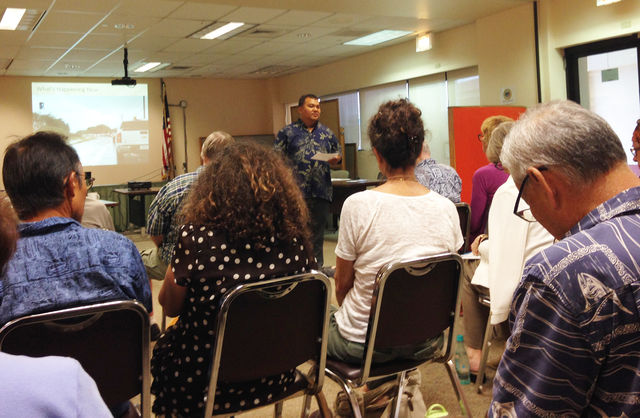LIHUE — Transportation problems Kauai residents experience on a regular basis took center stage during the Community Advisory Committee meeting on Monday “What I’m hearing from CAC members and the general public is that we have problems now, and it’s
LIHUE — Transportation problems Kauai residents experience on a regular basis took center stage during the Community Advisory Committee meeting on Monday
“What I’m hearing from CAC members and the general public is that we have problems now, and it’s hard to think about what it’ll be like 20 or 30 years from now when we’re not addressing what’s happening today,” said Lee Steinmetz, transportation planner for Kauai County.
The biggest transportation issue Kauai residents have today is congestion, especially in Kapaa, he said.
“We understand this is a significant problem people are concerned about,” he said.
One solution was a Kapaa relief route, which looked at installing a six-lane highway that would connect Kapaa to Lihue.
The relief route has been in discussion for about 20 years, and the 2000 General Plan based traffic growth patterns on it, Steinmetz said.
“We’ve been putting all our eggs in one basket for a very long time,” he said.
But last year, the Hawaii Department of Transportation determined, that for financial and environmental reasons, the project wasn’t feasible.
Since then, HDOT has been working on a study called Kapaa Transportation Solutions. Through the study, officials have identified several priority projects that will address congestion in Kapaa, Steinmetz said.
Those projects include adding a southbound lane along Kuhio Highway between Kapaa Bypass and Kuamoo roads, improving timing at the stoplights along Kuhio Highway at the intersections of Kukui, Haleilio and Kuamoo roads and adding a southbound lane between Kuamoo Road and Kapule Highway.
Some of those projects, including the widening of Kuhio Highway between Kapaa Bypass and Kuamoo roads and signal turning improvements in Kapaa are already in motion, Steinmetz said.
Construction for one of the improvements — the widening of Kuhio Highway between Kapaa Bypass and Kuamoo roads — is expected to start in 2018.
The final price tag, which includes several other improvement projects, is about $6.7 million.
During the meeting, Steinmetz also updated the audience on the county’s approach to transportation in the General Plan and Multimodal Transportation Plan policies.
The big question is how should the General Plan address transportation, he said.
Gabriela Taylor, who attended Monday’s meeting, believes there are several traffic solutions the CAC can address in the general plan update. One is to declare a moratorium on resort development in Kapaa and Wailua.
“There are three resorts already permitted, which including staff as well as tourists, translates to at least 1,600 additional cars pouring into an over-stressed Kuhio Highway,” she said. “The traffic is equally bad in Kapaa Town going north, but nothing is offered to remedy it. We are headed for disaster and distress when those hotels go online, in addition to 1,600 cars from Hokua Place.”
The General Plan also needs to promote sustainability, she said.
“We import 90 percent of our food, which is tantamount to disaster if and when another hurricane hits us,” she said. “Kauai will end up being an island for the wealthy when cheap oil runs out and we have to pay copious amounts of money for transportation to ship or fly in food.”
The Multimodal Land Transportation Plan, provides two scenarios: the baseline and the preferred scenario, Steinmetz said.
The baseline scenario shows what percentage of trips are taken in single occupancy vehicles, multiple occupancy vehicles, walking, biking, or via transit.
“It assumes, as we move to 2035, those pieces of the pie will remain the same. And as we grow, the proportion of additional cars and additional trips will be the same as it is now,” Steinmetz.
According to the baseline scenario, just over 50 percent of Kauai residents use single occupancy vehicles as their main mode of transportation.
According to the preferred scenario, while single occupancy vehicles will the most popular mode of transportation, the number of people walking, taking bikes or using transit will increase, Steinmetz said.
The preferred scenario is also a plan that includes six programs that can be implemented as part of an islandwide transportation network.
Those programs are: county roads, transit, bicycle, pedestrian, agricultural transportation and land use.
A lot of people question if the preferred mode will work on the island, Steinmetz said.
He cited history, transportation apps like Uber and Lyft and Kauai residents who have started riding their bikes or the bus as an alternate mode of transportation as reasons why he believes it will.
“People can and will change,” he said.
The CAC will meet again on June 21 to discuss housing.


